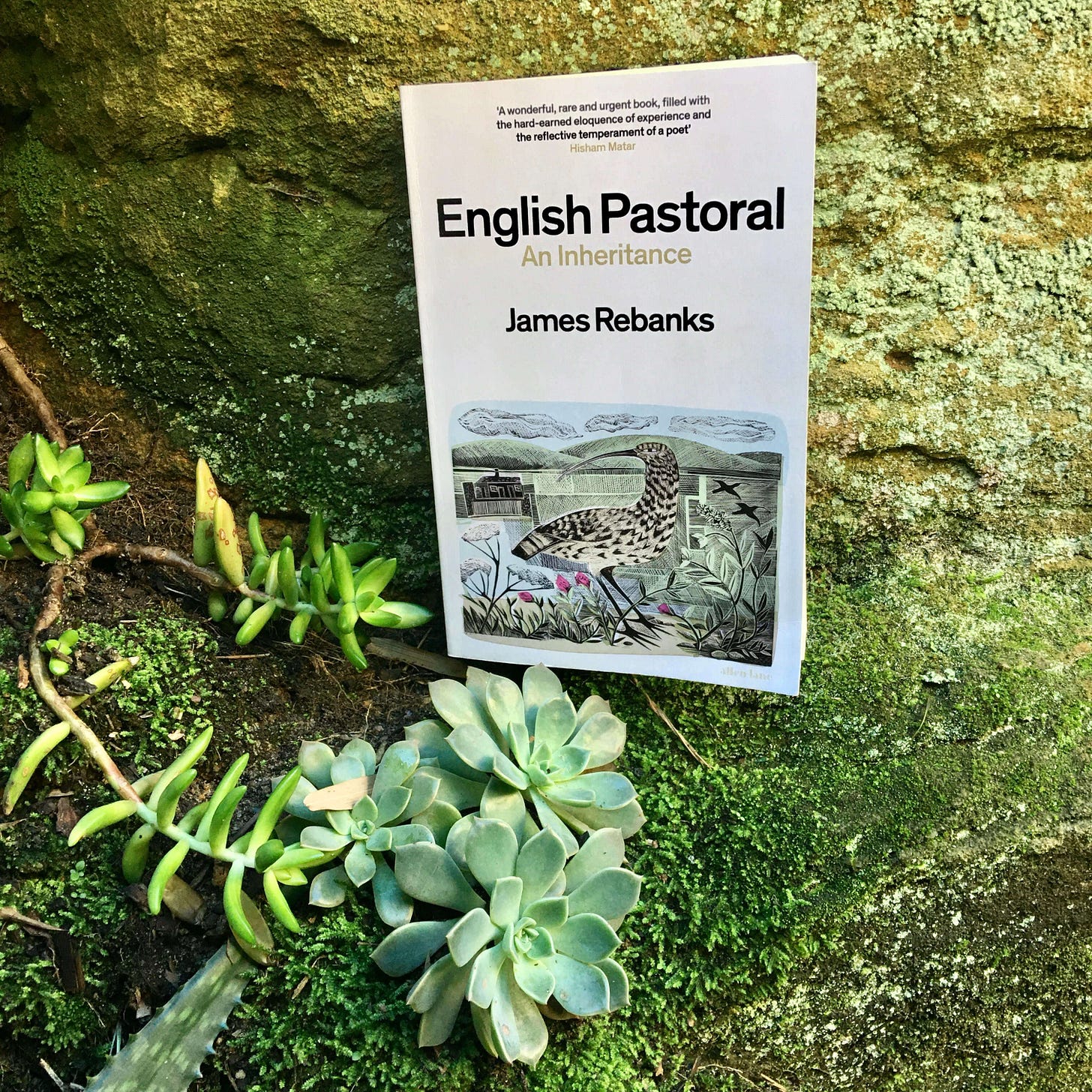Hi! I’m Hannah James, journalist, writer and editor, and this is where I review nature books, and think about nature-related topics out loud. Thanks for reading!
What I’m reading
For many of us city-dwellers who love nature (hi! It me), farms are a necessary evil. Without them, we are dimly aware, we would starve - but we would much prefer that flourishing, human-free nature take their place. Yet James Rebanks’s English Pastoral makes it clear that farms are the place where humans and nature meet and work together, often uneasily, and the way that we manage them has consequences that affect our present and reach far into our global future.
James Rebanks has a generations-deep insight into farming - and an extraordinary relationship to place. His family has been farming in the Lake District, where he still lives, for 600 years or more. In his first book, The Shepherd’s Life, he related how he won a place at Oxford University, earning a double first in history then - interestingly - returning to the farm. His second book, English Pastoral, is a passionate and powerful polemic about the past and future of farming.

Rebanks explains how we in the western world moved away from farming based on intimate knowledge of the land, that took into account biological limits of soil, crops and animals and allowed wildlife to flourish, and towards a relentlessly business-focused agricultural machine that treats everything as a commodity to be maximised, destroying precious ecosystems both human and natural in its wake.
“The last 40 years on the land were revolutionary and disrupted all that had gone before for thousands of years - a radical and ill-thought-through experiment that was conducted in our fields. I lived through those years. I was a witness.”
Separated into three parts, Nostalgia, Progress and Utopia, the book might more simply be described as covering the past, the present and the future. In Nostalgia, Rebanks recalls what his grandfather taught him: “the old ways - and just in time, because they were starting to die out all around us”.
Running an old-fashioned mixed, rotational farm, Grandad grew hay, silage, barley, oats for the horses, turnips for the sheep and potatoes, cabbages, lettuces, carrots and onions for the house. He kept dairy cattle, beef cattle, three breeds of sheep, pigs, horses, hens for eggs, and ducks and turkeys to sell at Christmas.
“My grandfather was rooted in work, connected to the soil and the crops and the animals upon it. I loved his closeness to the land.”
Grandad knew each animal, each field and each plant on his farm. He walked behind the plough, carefully removing curlews’ nests from the earth and replacing them after he’d passed. He made and mended things and rarely shopped, enjoying the company of wild things or of his community of farming peers.
“There was no shame in having very little, Grandad said, quite the opposite. It was better to hold on to their freedoms, even if it meant being poor by modern standards.”
Yet it was a hard life, too. I think of Ronald Blythe’s Akenfield, an extraordinary work of social history that tells the story of a Suffolk village in the 1960s in its residents’ own words, revealing just how crushing the physical work of farming was, and how destructive the poverty. If I ever retained a scrap of sentimental illusion about rural life in days gone by, that book (and Tess of the D’Urbervilles) killed it stone dead.
Rebanks’s depiction of farming’s past is far less bleak, but retains a knowledge of its difficulty that is etched in his own flesh and bone. Farmers were tough people battling nature’s whims to eke a living out of hard ground. When a bout of disease or a bad winter could so easily ruin them, is it any wonder farmers - exhausted by the grind of relentless physical toil - turned so readily to the modern miracles of pesticides, antibiotics and machines that promised less labour and better productivity?
Rebanks has compassion:
“If the past had been easy we would not have abandoned it quite so readily.”
He is also realistic. The Progress chapter reveals both why we abandoned the old ways, but also how we got the new ways so wrong. The appeal of this new way of farming is that it removes many of the vagaries of nature: pesticides will safeguard you against diseases that blight crops; antibiotics will keep your animals alive; creating bigger fields by eliminating those wildlife-rich ancient hedges will grant you economies of scale; fertilisers meant you could harvest two, three or four crops a year instead an impoverished one.
“The chemists were freeing agriculture and the human food chain from its eternal natural constraints.”
Radically increasing productivity at any cost also seemed the right thing to do, in the wake of food shortages during the Depression and the Second World War. Rebanks quotes President Nixon’s secretary of agriculture, Earl Butz:
“Before we go back to an organic agriculture in this country, somebody must decide which 50 million Americans we are going to let starve or go hungry.”
No one, though, had any idea that the land - and eventually, we ourselves - would pay such a heavy price for these new technologies. But it was becoming increasingly clear - and when Rebanks read Rachel Carson’s The Silent Spring, its dire warnings rang frighteningly true. The curlews were vanishing, the insects were long gone, the farm workers were no longer needed and local communities were fracturing.
“In place of an old patchwork landscape full of working people, diverse farm animals and crops, with lots of farmland wildlife, a blander, barer, simpler, denatured and unpeopled landscape had emerged.”
Those natural constraints, it turns out - the need to rotate crops to secure nitrogen in the soil rather than constantly pour fertilisers on the exhausted land; the natural limits to how much meat or milk animals can provide that advanced genetic engineering was attempting to override - were vital for the system to keep going.
“Farmers, egged on by politicians, economists and big business, were trashing the very systems on which life on earth depended, and barely knew they were doing it until it was too late.”
“The economists are wrong. Farming is not a business like any other because, crucially, it takes place in a natural setting and affects the natural world directly and profoundly.”
The Utopia chapter, as you’d expect, explores what we - farmers and non-farmers alike - might do to help those systems recover. Rebanks rewilds the course of his river, plants wildflowers, restores wetlands, brings back tough native breeds of sheep and cattle, and lays hedges again back in their centuries-old lines.
“We need to put farming and nature back together, not drive them further apart.”
It isn’t the job of individual farmers alone, of course - and in fact, Rebanks is careful to point out that stewarding his land in an ecologically responsible fashion means it is far from financially viable (he puts it more bluntly: “Farming for nature is economic suicide”). To support his family he must do other work - including writing books, I assume. Restoring ecological balance to the land requires governments, and we the people, to play our part, too.
“We can work the land and still have healthy soil, rivers, wetlands, woodland and scrub. We can have fields full of wild flowers and grasses, swarming with insects, butterflies and birds. We just have to want this enough to legislate for it and pay for it. To do this we have to opt out of the cheap food dogma that has driven farming and food policy for the past few decades… We can build a new English Pastoral: not a utopia, but somewhere decent for us all.”
English Pastoral was book 31 for 2021. I’ve also been reading:
Paulina Bren, The Barbizon: the New York Hotel that Set Women Free
Kazuo Ishiguro, The Buried Giant
Anthony Trollope, Barchester Towers
Natalie Haynes, Jocasta’s Children
James Rebanks, English Pastoral
Akiko Busch, The Geography of Home
Thanks again for reading! Feel free to hit reply to this email to have a chat (I always write back!), press the heart button if you liked this, or comment.
Also! Follow me on Instagram @hannahjameswords, on Twitter @hannahjamesword and check out my website at hannahjameswords.com.








